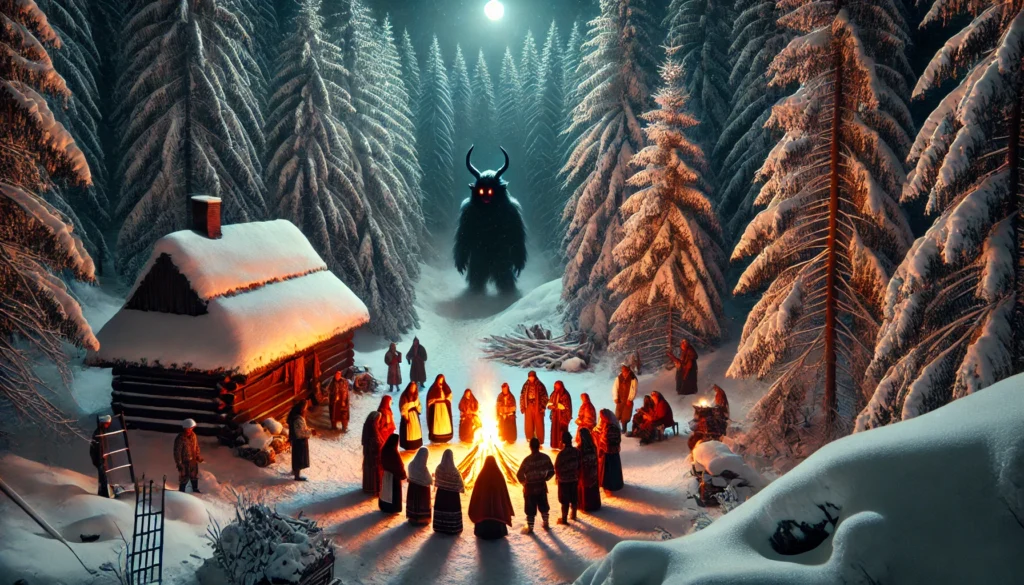
When we think of Christmas, images of Santa Claus, joy, and festive cheer come to mind. However, Christmas also brings tales of Krampus, a terrifying yet fascinating figure in parts of Europe. Known as the “Christmas Devil,” Krampus is a mythical creature rooted in folklore, blending dark traditions with festive celebrations. Let’s delve into the intriguing world of Krampus by exploring his origins, characteristics, cultural significance, and his association with Christmas.
Origins and Historical Context
Krampus originates from Central European folklore, particularly in the Alpine regions, including Austria, Germany, Hungary, and Slovenia. The word “Krampus” is derived from the German word krampen, meaning “claw.” His legend traces back to pre-Christian pagan traditions, where he was believed to be a horned god or a spirit that punished the wicked.
Krampus’ roots are tied to winter solstice traditions and the belief in spirits who would roam during the darkest days of the year. With the advent of Christianity, Krampus’ story evolved to fit into Christian narratives. He became a counterpart to St. Nicholas, the benevolent gift-giver, providing a stark reminder of the consequences of misbehavior.
Description and Characteristics
Krampus is a fearsome figure, often depicted as a half-goat, half-demon creature. His physical appearance is striking.
- Horns: Large, curling horns like those of a ram or a goat.
- Hair: Covered in thick, dark fur, giving him a wild, animalistic look.
- Face: A menacing face with sharp fangs and a long, pointed tongue.
- Accessories: He carries chains, bells, and a bundle of birch sticks called ruten, used to swat naughty children. In some depictions, he also carries a sack or basket on his back, in which he is said to cart away disobedient children.
This fearsome visage is meant to instill a sense of dread and caution, especially in children who misbehave.
Celebrations and Modern Interpretations
Krampus’ role is celebrated during the first week of December, particularly on December 5th, the eve of St. Nicholas Day. This night, known as Krampusnacht (Krampus Night), sees people dressing up as Krampus to roam the streets, often engaging in theatrical parades and playful scaring.
These modern celebrations include:
- Krampus Runs (Krampuslauf): People dress as Krampus, donning intricate masks and costumes, and run through towns to “terrorize” spectators in good fun.
- Festivals: Towns across Austria, Germany, and beyond host Krampus-themed events featuring performances, music, and traditional foods.
- Global Popularity: In recent years, Krampus has gained global recognition, becoming a pop culture phenomenon. Movies, books, and merchandise celebrate this darker side of Christmas.

Cultural Significance
Krampus serves as a counterbalance to the warmth and generosity symbolized by St. Nicholas. He embodies the concept of justice and consequence, reminding both children and adults that good behavior is rewarded while misdeeds are punished. This duality of reward and retribution is a recurring theme in many cultural traditions worldwide.
The legend also reflects the darker, more primal side of human nature, which contrasts with the lighthearted joy of Christmas. This balance makes Krampus a compelling figure who resonates with those drawn to folklore, myth, and the macabre.
How Did Krampus Become Associated with Christmas?
Krampus’ association with Christmas can be traced back to the integration of pagan and Christian traditions. As Christianity spread through Europe, local customs were adapted to fit the new religious framework. St. Nicholas, known for his generosity and kindness, was paired with Krampus, who handled the discipline. Together, they represented the dual aspects of morality: reward and punishment.
Over time, their stories merged, with Krampus taking on a role during the advent season. His frightful presence added an element of excitement and mystery to the otherwise cheerful festivities, ensuring that even the naughty among us were not forgotten.
Conclusion
Krampus is a fascinating figure that adds depth and complexity to Christmas traditions. His dark and menacing persona contrasts sharply with the festive joy of the season, serving as a reminder of the consequences of misdeeds. From his pagan origins to his modern-day celebrations, Krampus continues to capture imaginations around the world. Whether you see him as a moral guardian or simply a thrilling character, the Christmas Devil ensures that the holiday season remains as intriguing as it is festive.


